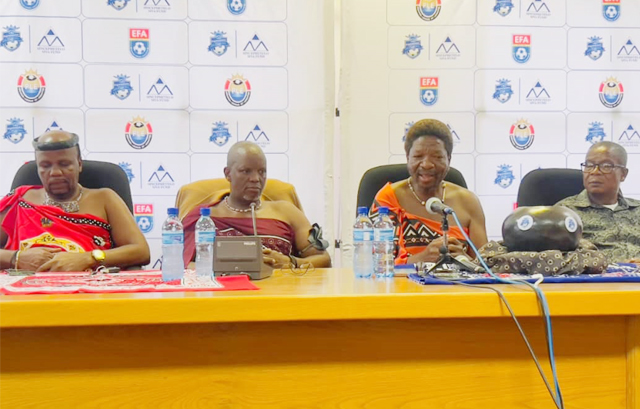By WLSA- Swaziland | 2019-08-08

Yesterday Women and Law in Southern Africa (WLSA) engaged in a march against the increasing violence against women and children along with partner organisations.
These were made up of the Council of Swaziland Churches (CSC), Swaziland Action Group Against Abuse (SWAGAA), World Vision, Kwakha Indvodza (KI), Swaziland National Association of Teachers (SNAT), Trade Union Congress of Swaziland (TUCOSWA), Swaziland Union of Students (SNUS), Swaziland Rural Women’s Assembly (SRWA), SOS Children’s Village and Coalition of Informal Economy Associations of Swaziland (CIEAS).
The march was also attended by the Regional Member of Parliament for the Manzini region.
This march was triggered by the fact that over the past few months, we have been reading reports of women and children being murdered by their husbands/partners and fathers, respectively. With the Sexual Offences and Domestic Violence (SODV) Act having been passed into law, the question on many people’s minds is why the violence and killings are continuing despite the harsh sentences that the Act prescribes.
It would appear that the violence is increasing rather than decreasing and this trend is worrying to say the least. Many are placing the blame of the “increase” on the enactment of the SODV Act, though they are unable to explain why they arrive at this supposition.
Perhaps the supposed “increase” is due to the fact that the offences are now all charged under the SODV Act, whereas previously, the offenders were charged under various provisions of the Criminal Procedure and Evidence Act and Common law.
Whatever the position may be, the prevalence of violence has reached alarming proportions and the country needs to declare it an emergency. Perhaps there is a need to address it in the same manner as the HIV pandemic was addressed, and design programmes specifically for this. Resources should be availed to drive the programmes for their effectiveness.
Before the programmes can be designed, there would need to be action research conducted to inform the interventions that would need to be implemented. The research would have to identify the drivers of violence to ensure that the programs will yield results.
Though a study was conducted on the drivers of violence against children, the findings would not be relevant to the drivers of violence against women. The study commissioned by the Deputy Prime Minister’s office in partnership with UNICEF was conducted and published in 2016, when there was no legislation dedicated to sexual and gender-based violence (SGBV) and within a different context.
interventions
Among some of the interventions would perhaps be programmes specifically designed for perpetrators. Though it is acknowledged that the Correctional Services have programmes for offenders, they are more inclined towards rehabilitation and integration of convicts back into the communities from which they come.
The Correctional Services programmes are not necessarily reformative in nature, with the result of generating repeat offenders. There is also a supposition that perpetrators repeatedly commit the same offence because when in custody, they have all their basic needs taken care of; they have shelter, clothing, three meals a day and basic amenities taken care of by the state. They would trade their freedom for being free from taking care of their responsibilities towards their families.
This then raises another question of whether the socio-economic situation of the country could be a contributing factor to the alarming rates of violence; the argument here being that men, out of frustration of being unable to provide for their families, then opt to kill them and end all their suffering.
differing views
There are so many differing views and opinions out there, that there is a need to address them all through research and not from assumptions and suppositions. These opinions are very detrimental to the fight against SGBV because they also find their ways into the justice system which should act as the protectors of victims and survivors.
All said and done, there is a very alarming component to the latest murders that people seem not to notice. These killings are not carried out in impulse or in the heat of the moment; what could be called crimes of passion. The latest killings have been premeditated by the perpetrator; this is evident from the choice of weapon that the perpetrator uses. The use of guns, poison and even drowning shows that there was some planning that took place before the crime was committed. So we then come back to the question of why the perpetrator opted for murder than another solution.
This question is particularly relevant when taking into account that some of these murders are committed in the presence of other people, with no attempt to hide the evidence or to evade prosecution.
The intention of all the questions and suggestions in this article are meant to provoke a discussion that should act as a catalyst towards designing interventions that will bring an end to SGBV, including the murder of women and children.
The WLSA director at the march yesterday said “government and the police alone cannot eradicate the scourge of domestic violence” and we wish to add that “strict implementation of the SODV Act” is not enough to end violence against women and children. The problem has reached crisis levels and the nation at large is required to take a stand and address the problem in all sectors.
share story
Post Your Comments Below

Clover Swaziland has called upon minister of finance to reconsider the current taxation structure...

INGWENYAMA Cup Chairman Prince Hlangabeza has called for violence-free games and urged teams to a...

BUSINESS Eswatini (BE) Vice President Andrew le Roux has stepped down from his position permanent...

United States President Donald Trump has announced sweeping new import taxes on all goods enterin...
All material © Swazi Observer. Material may not be published or reproduced in any form without prior written permission.
Design by Real Image Internet